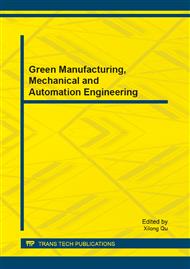[1]
Vanloocke R., et al., Soil and groundwater contamination by oil spills; problems and remedies [J]. International Journal of Environmental Studies, 1975. 8(1-4): 99-111.
DOI: 10.1080/00207237508709721
Google Scholar
[2]
Adenipekun C.O. and Isikhuemhen O.S., Bioremediation of engine oil polluted soil by the tropical white rot fungus, Lentinus squarrosulus Mont. (Singer) [J]. Pakistan journal of biological sciences: PJBS, 2008. 11(12): 1634-1637.
DOI: 10.3923/pjbs.2008.1634.1637
Google Scholar
[3]
Korenblum E., et al., Molecular Analysis of the Bacterial Communities in Crude Oil Samples from Two Brazilian Offshore Petroleum Platforms [J]. International Journal of Microbiology, 2012. 2012(2012).
DOI: 10.1155/2012/156537
Google Scholar
[4]
Vincent A.O., et al., Microbial Degradation and its Kinetics on Crude Oil Polluted Soil [J]. Research Journal of Chemical Sciences, 2011. 1(6): 8-14.
Google Scholar
[5]
Rajasekar A., et al., Bacterial degradation of petroleum hydrocarbons [J]. Microbial Degradation of Xenobiotics, 2012: 339-369.
Google Scholar
[6]
Torsvik V. and Øvreås L., Microbial diversity and function in soil: from genes to ecosystems [J]. Current Opinion in Microbiology, 2002. 5(3): 240-245.
DOI: 10.1016/s1369-5274(02)00324-7
Google Scholar
[7]
Tsai Y.L. and Olson B.H., Detection of low numbers of bacterial cells in soils and sediments by polymerase chain reaction [J]. Applied and environmental microbiology, 1992. 58(2): 754-757.
DOI: 10.1128/aem.58.2.754-757.1992
Google Scholar
[8]
Lecomte J., St‐Arnaud M., and Hijri M., Isolation and identification of soil bacteria growing at the expense of arbuscular mycorrhizal fungi [J]. FEMS microbiology letters, 2011. 317(1): 43-51.
DOI: 10.1111/j.1574-6968.2011.02209.x
Google Scholar
[9]
Wilson I.G., Inhibition and facilitation of nucleic acid amplification [J]. Applied and environmental microbiology, 1997. 63(10): 3741-3751.
DOI: 10.1128/aem.63.10.3741-3751.1997
Google Scholar
[10]
Yeates C., et al., PCR amplification of crude microbial DNA extracted from soil [J]. Letters in Applied Microbiology, 2003. 25(4): 303-307.
DOI: 10.1046/j.1472-765x.1997.00232.x
Google Scholar
[11]
Zhou J., Bruns M.A., and Tiedje J.M., DNA recovery from soils of diverse composition [J]. Applied and environmental microbiology, 1996. 62(2): 316-322.
DOI: 10.1128/aem.62.2.316-322.1996
Google Scholar
[12]
Zucchi M., et al., Response of bacterial community during bioremediation of an oil‐polluted soil* [J]. Journal of Applied Microbiology, 2003. 94(2): 248-257.
DOI: 10.1046/j.1365-2672.2003.01826.x
Google Scholar
[13]
Sambrook J. and Russell D.W., Isolation of high-molecular-weight DNA from mammalian cells using proteinase K and phenol [J]. Cold Spring Harbor Protocols, 2006. 2006(1): pdb. prot4036.
DOI: 10.1101/pdb.prot4036
Google Scholar
[14]
Sambrook J. and Russell D.W., Purification of plasmid DNA by precipitation with polyethylene glycol [J]. Cold Spring Harbor Protocols, 2006. 2006(1): pdb. prot3907.
DOI: 10.1101/pdb.prot3907
Google Scholar
[15]
Cardinali G., Bolano A., and Martini A., A DNA extraction and purification method for several yeast genera [J]. Annals of microbiology, 2001. 51(1): 121-130.
Google Scholar
[16]
Watanabe K., Hamamura N., and Kaku N., Molecular identification of microbial populations in petroleum-contaminated groundwater [J]. Methods in Biotechnology, 2004. 16: 235-242.
DOI: 10.1385/1-59259-765-3:235
Google Scholar
[17]
Watanabe K., Kodama Y., and Harayama S., Design and evaluation of PCR primers to amplify bacterial 16S ribosomal DNA fragments used for community fingerprinting [J]. Journal of microbiological methods, 2001. 44(3): 253-262.
DOI: 10.1016/s0167-7012(01)00220-2
Google Scholar


